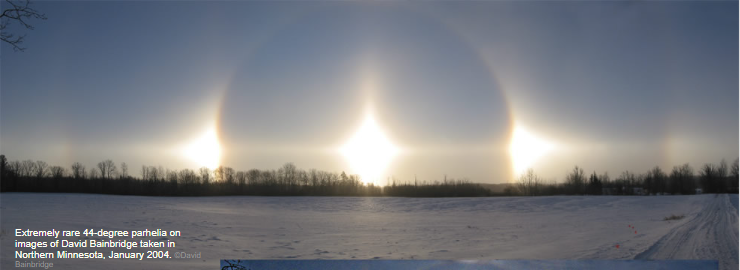44° Parhelia
Exploring the Phenomenon of 44° Parhelia
When it comes to atmospheric optics, there are many fascinating and rare phenomena to observe. One such phenomenon is the 44° parhelia, which are exceptionally rare occurrences in the sky. These unique halos appear as colored "smudges" on each side of the sun, located twice as far from it along the parhelic circle as the sundogs. While they may initially resemble fragments of the 46° halo, a closer look reveals that they are distinct from it. In this article, we will delve into the world of 44° parhelia, exploring their formation, rarity, and the intriguing observations captured in Northern Minnesota in January 2004.
The 44° parhelia have been a subject of fascination among atmospheric optics enthusiasts for quite some time. They were first photographed during the famous Saskatoon display on December 3, 1970, where they made their grand debut alongside a Kern arc. Since then, purely visual sightings of these parhelia have occasionally been reported. What makes these halos so unique is that they are rare examples of multiple scattering. Essentially, they can be thought of as "sundogs of sundogs." Rays that have already passed through a plate crystal, which would typically form a sundog, intercept a second plate crystal and undergo further deflection. This double deflection results in a minimum deviation angle of 44°.
To witness the elusive 44° parhelia, specific atmospheric conditions need to be met. Very high concentrations of plate crystals are required to create these halos. It is also worth noting that alternative explanations have been proposed, suggesting that peculiar geometries may contribute to the formation of these parhelia using only single crystal scattering, which is typically responsible for producing halos. This ongoing debate among atmospheric optics experts adds to the allure and mystery surrounding these rare phenomena.
The Minnesota images captured in January 2004 by David Bainbridge offer a captivating glimpse into the world of atmospheric optics. Apart from the 44° parhelia, these images potentially show other fascinating halos, such as "reflected" Lowitz arcs and 46° contact arcs. These additional phenomena further highlight the complexity and beauty of atmospheric optics, where a combination of factors can result in stunning displays in the sky.
For those fortunate enough to witness diamond dust displays with exceptionally bright sundogs like the ones observed in Northern Minnesota, it is advisable to routinely check and photograph the sky twice as far from the sun. This practice may reveal the presence of the rare 44° parhelia and potentially other intriguing halos. By exploring different regions of the sky, observers can gain a deeper understanding of the diverse atmospheric phenomena that can occur.
In conclusion, the 44° parhelia are remarkable examples of atmospheric optics, representing rare occurrences of multiple scattering. These halos, often referred to as "sundogs of sundogs," require specific atmospheric conditions and high concentrations of plate crystals to form. While their exact formation mechanisms are still debated, they continue to captivate researchers and enthusiasts alike. The images captured in Northern Minnesota in January 2004 offer a glimpse into the beauty and complexity of atmospheric optics, showcasing not only the 44° parhelia but also potentially other intriguing halos. By embracing the wonder of the natural world and observing the sky with curiosity, we can uncover the secrets hidden within these mesmerizing atmospheric phenomena.

Extremely rare 44-degree parhelia on images of David Bainbridge taken in Northern Minnesota, January 2004. ©David

The halos of interest in this panorama are the coloured 'smudges' on each side of the sun and twice as far from it along the parhelic circle as the sundogs. At first sight they could simply be brighter fragments of the 46� halo but the enlarged lower view shows that they are not. They are closer to the sun.
They are the fabled 44� parhelia. They were previously photographed during the famous Saskatoon display of December 3, 1970 (during which a Kern arc was also reported but not photographed) and purely visual sightings were occasionally reported since.
The 44� parhelia are rare examples of multiple scattering. In effect they are 'sundogs of sundogs' formed by rays that have already passed through a plate crystal - and would otherwise have formed a sundog - intercepting a second plate crystal and being further deflected. The double deflection has a minimum deviation angle of 44�. Very high plate crystal concentrations are needed. As an alternative explanation, peculiar geometries have been invoked to form the parhelia from only the single crystal scattering that normally produces halos.
When observing diamond dust displays with very bright sundogs like this one it is well worth routinely checking - and photographing - the sky twice as far from the sun.
As if 44� parhelia were not enough, the Minnesota images possibly also show 'reflected' Lowitz arcs and 46� contact arcs.
Note: this article has been automatically converted from the old site and may not appear as intended. You can find the original article here.
Reference Atmospheric Optics
If you use any of the definitions, information, or data presented on Atmospheric Optics, please copy the link or reference below to properly credit us as the reference source. Thank you!
-
<a href="https://atoptics.co.uk/blog/44-parhelia/">44° Parhelia</a>
-
"44° Parhelia". Atmospheric Optics. Accessed on December 22, 2024. https://atoptics.co.uk/blog/44-parhelia/.
-
"44° Parhelia". Atmospheric Optics, https://atoptics.co.uk/blog/44-parhelia/. Accessed 22 December, 2024
-
44° Parhelia. Atmospheric Optics. Retrieved from https://atoptics.co.uk/blog/44-parhelia/.